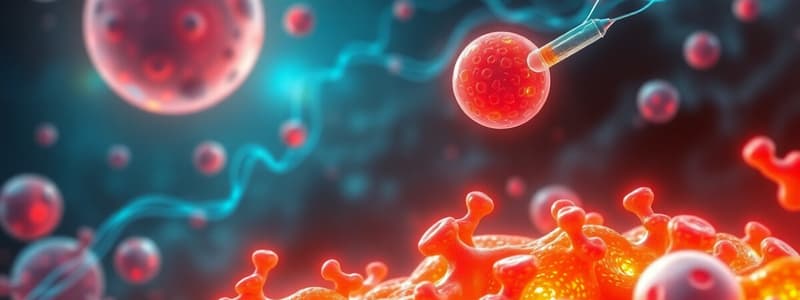Podcast
Questions and Answers
Which of the following is NOT a source of blood glucose in the human body?
Which of the following is NOT a source of blood glucose in the human body?
- Glycogen degradation
- Carbohydrates in diet
- Lipid metabolism (correct)
- Gluconeogenesis
What is the main mechanism by which glucose is transported into cells against a concentration gradient?
What is the main mechanism by which glucose is transported into cells against a concentration gradient?
- Passive diffusion across the membrane
- Na+-independent facilitated diffusion transport
- Na+-monosaccharide cotransporter system (correct)
- Endocytosis
Which glucose transporter is primarily involved in the facilitated diffusion of glucose into most tissues?
Which glucose transporter is primarily involved in the facilitated diffusion of glucose into most tissues?
- GLUT-10
- GLUT-3
- GLUT-1 (correct)
- GLUT-4
What role does fructose play in glucose metabolism?
What role does fructose play in glucose metabolism?
During periods of fasting, which process primarily provides glucose for the bloodstream?
During periods of fasting, which process primarily provides glucose for the bloodstream?
What is the main end product of anaerobic glycolysis?
What is the main end product of anaerobic glycolysis?
Which process utilizes glucose to produce NADPH and ribose-5 phosphate?
Which process utilizes glucose to produce NADPH and ribose-5 phosphate?
Which of the following is a source of polysaccharides in the diet?
Which of the following is a source of polysaccharides in the diet?
In which compartment does glycolysis primarily occur?
In which compartment does glycolysis primarily occur?
What is the first step of glucose utilization for energy production?
What is the first step of glucose utilization for energy production?
Flashcards are hidden until you start studying
Study Notes
Glucose Metabolism
- Glucose is the primary carbohydrate in blood and the primary fuel for human cells.
- A constant glucose supply is essential for human life.
- Glucose is the preferred energy source for the brain.
- Glucose is required for cells with few or no mitochondria, such as Red Blood Cells (RBCs).
- Glucose is the primary energy source for exercising muscles, through anaerobic glycolysis.
Glucose Transport into Cells
- Two main mechanisms move glucose into cells:
- Na+-independent facilitated diffusion (GLUT):
- Glucose moves with the concentration gradient.
- No energy (ATP) is required.
- GLUTs are a family of at least 14 glucose transporters.
- Na+-monosaccharide cotransporter system (SGLUT):
- Glucose moves against the concentration gradient.
- This is an energy-requiring process.
- Glucose movement is coupled with Na+ movement into the cell.
- SGLUT is found in the epithelial cells of the intestine and renal tubules.
- Na+-independent facilitated diffusion (GLUT):
Sources of Blood Glucose
- Blood glucose can be obtained from three main sources:
- Carbohydrate in the diet: Carbohydrates are the primary source of glucose following meals. Excess glucose is stored as glycogen in the liver and skeletal muscles.
- Glycogen Degradation (Glycogenolysis): During fasting, liver glycogen is broken down to release glucose into the blood. During muscular exercise, muscle glycogen is broken down to provide energy for muscles.
- Gluconeogenesis (Glucose Synthesis): This is the synthesis of glucose from non-carbohydrate sources like certain amino acids. Gluconeogenesis occurs during prolonged fasting.
Sources of Glucose from Carbohydrate Diet:
- Carbohydrates in the diet are digested into glucose, fructose, and galactose.
- Free Monosaccharides: Glucose and fructose are freely available. Fructose is converted to glucose in the liver.
- Disaccharides: Sucrose, lactose, and maltose are digested by disaccharidases (sucrase, lactase, and maltase) into their respective monosaccharides.
- Sucrose: glucose + fructose
- Lactose: glucose + galactose
- Maltose: glucose + glucose
- Polysaccharides: Starch (plant source) and glycogen (animal source) are broken down by amylase into maltose, then by maltase into glucose.
Fates of Blood Glucose
- Blood glucose can be utilized in catabolic or synthetic pathways:
- Catabolic Pathways:
- Energy Production (ATP): Glucose is broken down via glycolysis, the Krebs cycle, and oxidative phosphorylation.
- Anaerobic Glycolysis: Produces lactate.
- Aerobic Glycolysis: Produces pyruvate, then enters the Krebs cycle to produce ATP through oxidative phosphorylation.
- Synthetic Products: Glucose is used to generate NADPH and ribose 5-phosphate through the hexose monophosphate pathway.
- Energy Production (ATP): Glucose is broken down via glycolysis, the Krebs cycle, and oxidative phosphorylation.
- Synthetic Pathways: Glucose is used to synthesize:
- Glycogen
- Lipogenesis (fat synthesis)
- Protein synthesis
- Other carbohydrates
- Catabolic Pathways:
Glucose Metabolism Summary Diagram:
- Hexose Monophosphate Pathway produces NADPH and ribose 5-phosphate.
- Glycogen Synthesis utilizes glucose to form glycogen for storage.
- Glycolysis breaks down glucose, leading to pyruvate.
- Anaerobic Glycolysis produces lactate in the absence of oxygen and mitochondria.
- Aerobic Glycolysis produces pyruvate with oxygen and mitochondria, which then enters the Krebs cycle.
- Krebs Cycle utilizes pyruvate to produce NADH, FADH2, and CO2.
- Electron Transport Chain (ETC) utilizes NADH and FADH2 from the Krebs cycle to generate ATP through Oxidative Phosphorylation.
Studying That Suits You
Use AI to generate personalized quizzes and flashcards to suit your learning preferences.




